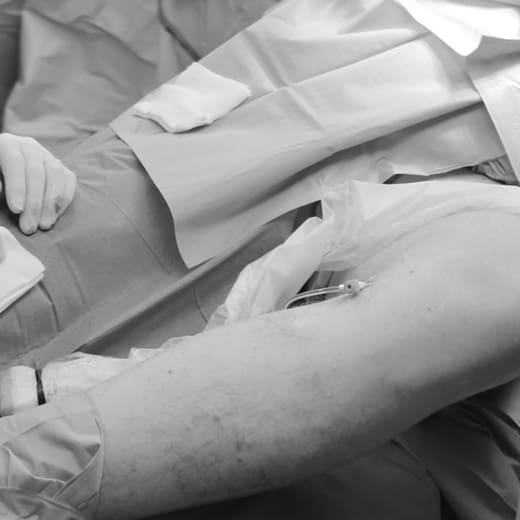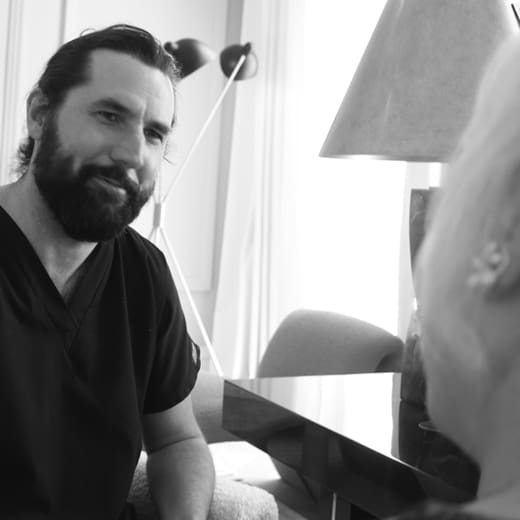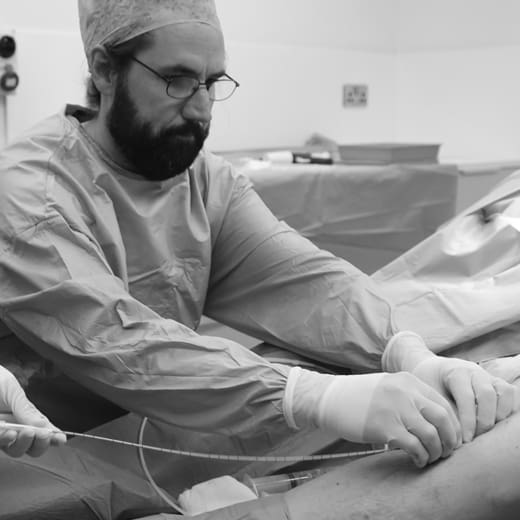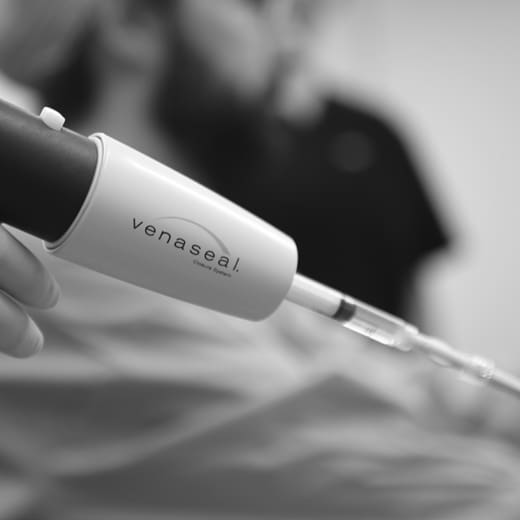McKeown Medical
167 Bath Street, Glasgow, G2 4SQ
Radiofrequency ablation (RFA) and endovenous laser ablation (EVLA) are two minimally invasive treatments used to effectively treat varicose veins, but what’s the difference?
Date posted — 29.09.24
Radiofrequency ablation (RFA) and endovenous laser ablation (EVLA) are two minimally invasive treatments used to effectively treat varicose veins. Both procedures aim to close off problematic veins, preventing them from causing further symptoms and leading to their eventual absorption by the body.
RFA uses radiofrequency energy to generate heat within the vein. A thin catheter is inserted into the vein through a small incision, and once inside, the radiofrequency energy is delivered through the catheter, causing the vein walls to heat up, collapse, and seal shut. This treatment is performed under local anaesthetic, and most patients experience little discomfort, with a quick recovery time and minimal scarring.
EVLA works on a similar principle but uses laser energy instead of radiofrequency to achieve the same result. During EVLA, a laser fibre is guided into the affected vein, and when activated, the laser’s heat damages the vein walls, causing them to collapse and close off.
Like RFA, EVLA is performed under local anaesthetic and is considered highly effective for treating varicose veins. Both RFA and EVLA offer excellent outcomes with low risk of complications, making them preferred options over more invasive surgical treatments. These procedures allow patients to resume normal activities relatively quickly, with significant improvement in both the appearance of the legs and the symptoms associated with varicose veins.

Although RFA and EVLA are very similar in terms of success rates at shutting down larger varicose veins, several studies have suggested that RFA may be associated with lower complication rates, so RFA is our preferred traditional endovenous method.
An even newer endovenous technique known as Venaseal™, however, is an exciting addition to our practice. The success rate of Venaseal™ is similar to both RFA and EVLA. However, it uses glue rather than heat to close the veins and is associated with even less discomfort.
The benefits of RFA for treating varicose veins are numerous, making it a popular choice for both patients and doctors. RFA is minimally invasive, requiring only a small incision to insert a catheter into the affected vein. This results in less pain, minimal scarring, and a quicker recovery time compared to traditional surgical methods.
The procedure is typically performed under local anaesthetic, reducing the risks associated with general anaesthetic. RFA is highly effective, with a success rate of over 90%, and provides long-term relief from the symptoms of varicose veins, such as pain, swelling, and leg fatigue. Additionally, patients can usually return to their normal activities within a day or two, making it a convenient option for those looking for an effective and efficient treatment.
Dr Alex Vesey is our expert consultant vascular surgeon who heads up our varicose vein team. Listen to him explain the Radiofrequency Ablation (RFA) treatment.

RFA is considered better than EVLA for treating varicose veins in our practice because it’s generally a more comfortable experience and has a lower risk of complications.
RFA typically causes less post-procedural pain and bruising because it uses radiofrequency energy, which generates a gentler heat compared to the intense heat from laser energy used in EVLA. This can result in a smoother recovery with less discomfort for patients.
Additionally, RFA has a slightly lower risk of nerve damage, particularly in areas where veins are close to nerves, such as the lower leg. The procedure’s outcomes are highly successful and comparable to EVLA but with a more favourable side effect profile, making RFA a preferred option for many patients and clinicians.
Recently, we have introduced the Venaseal™ procedure. Venaseal™ is even less invasive because it avoids the use of heat altogether, which causes even less discomfort whilst still achieving excellent closure rates and long-term outcomes for patients.
If you’d like to find out if RFA is the right treatment for you, the first step is to fill out our online consultation form. From there, our team will be able to arrange an initial consultation and ultrasound scan, and we can work together to create a treatment plan that is tailored to your needs.

If you're struggling with the discomfort, swelling, or unsightly appearance of varicose veins, Radiofrequency Ablation (RFA) could be the solution...

When it comes to treating varicose veins, VenaSeal™ has emerged as a revolutionary option that offers a minimally invasive and...

Varicose veins are enlarged, twisted veins that often appear just under the skin, primarily in the legs and feet.
1 / 3
2 / 3
3 / 3

If you're struggling with the discomfort, swelling, or unsightly appearance of varicose veins, Radiofrequency Ablation (RFA) could be the solution...

When it comes to treating varicose veins, VenaSeal™ has emerged as a revolutionary option that offers a minimally invasive and...

Varicose veins are enlarged, twisted veins that often appear just under the skin, primarily in the legs and feet.
Thank you to our incredible patient for allowing us to share these pictures with you.
This patient has been with me for years but the thing we have always struggled with has been the texture of the skin around the mouth and lower face which has had a lot of sun over the years.
We’d tried less invasive options but ultimately when the skin changes get to this level the only thing that makes a dramatic improvement is full field resurfacing.
There is literally no other treatment capable of undoing sun damage like this. The patient is only a few weeks post-op and still a bit red so she is wearing make up to hide the redness, but already obsessed by the texture of her new skin.
What do you think?
If you`d like to know if you`d benefit from this treatment send us a DM with some pictures or visit the link in our profile for more information on full laser resurfacing.

We`re going live on Wednesday at 7PM! Join Dr Rhona and Dr Iain (@driainmartin) on Instagram live, where they`ll be discussing everything about periods and heavy menstrual bleeding including:
What is “normal” when it comes to menstruation
Heavy periods - what is a heavy period and what might be causing it
Myths vs facts - getting the right information and the right treatment for period problems
They`ll also be answering your questions live, so if there`s anything you`d like to ask, leave a comment or head to our stories. We hope you can join us!

Since we are now in full swing filler season, I’m very grateful to this patient for allowing us to share her pictures to demonstrate how much lift we can achieve just using filler.
Discover more about our method at the link in our bio.

Summer is almost here! If you’re putting off wearing your favourite summer dresses and shorts because of varicose veins, now is the time to think about treatment.
Varicose veins aren’t just a cosmetic concern - they can ache and throb, as well as make us feel self-conscious, especially as the warmer weather approaches.
With so many treatments available, it can be difficult to know where to start. Here’s our lovely Dr Alex with a quick overview of how we can help reduce discomfort, improve appearance and boost your confidence in time for summer.
If you, or someone you know, have been thinking about treatment, now is a great time to explore your options with plenty of time to feel the benefits before summer - check the link in our bio for more details.

Now that spring has finally sprung we are very much in peak time for filler treatments in the clinic.
So many patients would benefit from filler, but are scared of them because of the horror stories so I wanted to share a few examples this week of what filler looks like - in the correct hands!
Here are some examples of the natural looks we achieve with the McKeown Method.
Discover more about our method at the link in our bio.

What a difference a week is! This is one of our patients just a week out from her deep plane face and neck lift by the ever so talented @bramhallplasticsurgery.
The deep plane technique is the most technically challenging facelift to perform and Russell remains the only surgeon in Scotland performing this procedure, which involves going much deeper into the face to reposition the tissues rather than just pull them tight.
The outcome is a much more effective rejuvenation, even in unflattering poses when your head is bent forward, and a result that lasts much longer than a traditional facelift.
What do you think?

Thank you so much to our wonderful patient for allowing us to share her before and after pictures. She’s around 6 weeks after full field resurfacing.
One of the great things about this treatment is that, in addition to wiping wrinkles away, it also gives some pretty impressive skin tightening too. If you look at her forehead, upper and lower eyelids you can really see how much tighter the skin is.
The stubborn forehead lines and lines through the eyebrows have gone and, of course, the lines around the mouth are significantly reduced. These will continue to improve for up to six months as the skin continues to heal. She’s still a little pink, which will fade over the next few months, but with a little tinted moisturiser you’d never know. The patient is over the moon.
What do you think?
We can now offer full laser resurfacing with sedation and you can see more about the procedure in the link in our profile.

Yesterday we announced that we’re the first clinic in Scotland to have the CoolSculpting® Elite so today I wanted to show you an example of the kind of results we can achieve with this treatment.
We’re so grateful to this patient for allowing us to share her results before and after CoolSculpting®. As you can see here, she had a stubborn area of fat around her belly which she was finding difficult to shift with diet and exercise alone.
She’s absolutely delighted with the result - what do you think?
For more information on CoolSculpting® and to get booked in to be ready for summer, check out the link in our bio.

Introducing CoolSculpting® Elite!
We’re delighted to announce that we now have the CoolSculpting® Elite, modelled here by our lovely nurse Niki! We’re excited to be the first clinic in Scotland to take delivery of the latest technology from CoolSculpting®, which has new and improved applicators to improve the contact between the machine and the skin, for even better results than before.
Now is the perfect time to have this treatment in time for the summer. To find out more about CoolSculpting® check the link in our bio.
